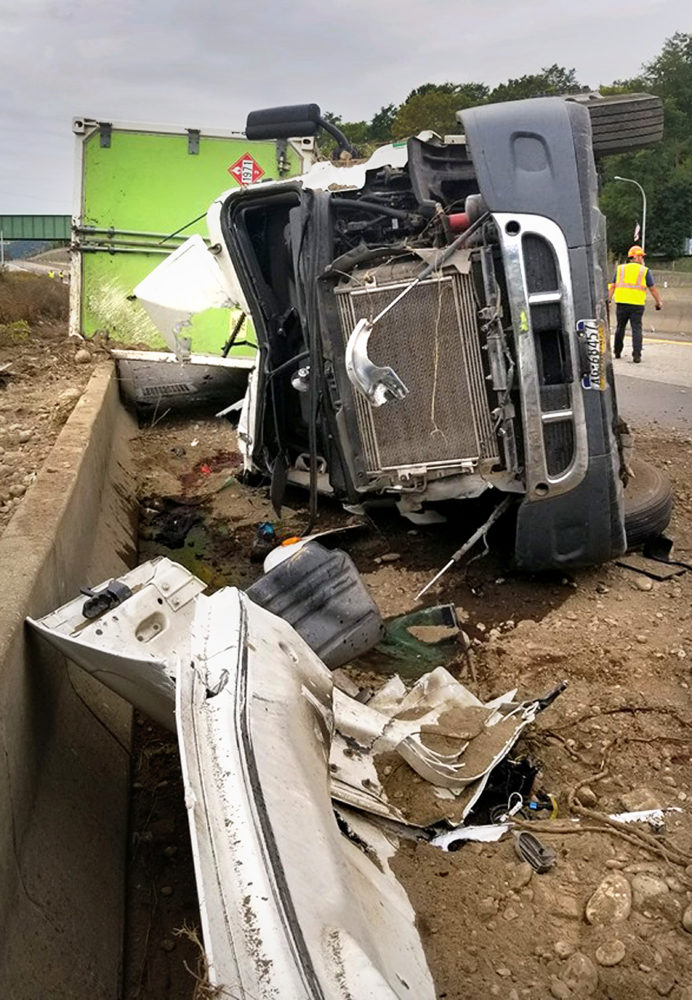Rig Driver Ejected In
1st Fatal XNG Crash
Gas Leaks, 80 Homes Evacuated Near I-88
By LIBBY CUDMORE • Special to www.AllOTSEGO.com

For Otsego 2000 President Nicole Dillingham, a key player in shifting gas-carrying XNG trucks out of Otsego County, said the truck crash west if Binghamton that killed a 52-year-old driver was a predictable tragedy.
This was the first fatal accident involving an XNG truck since the “virtual pipeline” emerged after state regulators blocked the proposed Constitution Pipeline in 2016.
“It’s very sad,” Dillingham said. “But those trucks were never fully tested, they’re prone to roll-overs and, if the conditions were right, they could explode.”
At 1 a.m. on Monday, Sept. 23, Broome County Sheriff’s deputies were called to the scene of a tractor-trailer accident on Interstate 88 eastbound at Exit 2 in the Town of Fenton.
Upon arrival, first responders noticed that the vehicle, an XNG Compressed Natural Gas truck had a hazardous material placard. The driver of the vehicle, identified as Jeffrey Lind, 52 years of age of Hallstead, Pa, was found deceased a short distance from the tractor. It is believed he was ejected from the vehicle upon impact.
Lind had been a driver for XNG for just under two months, according to John Pierce, president of Pierce Communications, the public relations firm retained by XNG. The company will be expected to have an attorney for truck accidents on hand to help deal with any legal proceedings.
The preliminary investigation and witnesses accounts indicate that Lind swerved to avoid striking a deer in the roadway. As a result, he lost control of the tractor trailer, struck the concrete Jersey barrier dividing the eastbound and westbound lanes, overturned then slid across the eastbound lanes coming to rest against the concrete barrier on the right-hand side of the eastbound lanes.
The trailer contained four tanks each filled with compressed methane gas. One tank within the trailer was damaged in the accident and, as a result, an unknown amount of compressed gas vented into the atmosphere, prompting the evacuation of 80 homes within a quarter mile radius of the scene.
“The containers holding the CNG were not breached in this incident,” said the XNG spokesman. “Gas was vented from the emergency relief system that is intentionally built in. Despite this, emergency responders, acting with an abundance of caution, decided to evacuate the area.”
Governor Cuomo declared a State of Emergency in the area and deployed emergency responders from the state Division of Homeland Security & Emergency Services, Department of Transportation, Department of Environmental Conservation Spills Response, and State Police.
“When serious accidents happen, the state jumps into action to help and our emergency responders move heaven and earth to protect our communities,” the governor said.
Traffic was also rerouted to avoid the accident scene, and the Chenango Valley and Chenango Forks central school district were both closed for the day.
Huston has developed a database that includes six incidents involving XNG trucks in Otsego County in 2016-18, when the trucks could be seen going up and down Route 205 every few minutes.
After a rollover outside Schuyler Lake, county Rep. Ed Frazier, R-Unadilla, opened discussions with XNG President John Nahill. With that, and pressure from groups like Otsego 2000, XNG shifted its trucks across Unadilla Creek into Chenango County, where Route 8 had been upgraded and widened to handle traffic to and from Chobani.
The trucks may be cutting across corners of Otsego County today, but they are not cutting across it as they used to, Dillingham said.
“I have my doubts that they’re really certified to carry hazardous materials,” she continued. “In other cases, the hazardous material is itself contained inside the truck so if the truck is damaged, it won’t leak. But with the XNG trucks, they’re not even trying. They’re designed to release hazardous cargo in an accident.”
“They’re designed to release the gas out of the top in an accident,” said activist William Huston. “But in almost all the crashes, the truck rolls over, so the gas is coming out of the side.”
If there was to be a fire as part of the accident, he said, the leaking gas could become “like a flamethrower.”
With an ignition temperature of 1,200 degrees, compressed natural gas is only flammable at 15 percent oxygen and 5 percent. “It is possible to get a bizarre set of circumstances where the vapor cloud meets an ignition source and creates a fuel-air bomb,” said Houston.
Though the truck involved in the accident was only carrying nine tons of CNG, they can carry as much as 12 tons. “That’s the equivalent of 120 tons of dynamite if that explodes,” he said. “That would destroy an entire neighborhood.”
The road was opened and the evacuation order was lifted around 4 p.m. that afternoon.
“We will continue to work with Broome County Office of Emergency Services to determine the cause of the accident and, as always, we will use this incident to learn about our processes and procedures and to make any needed adjustments to help improve our strong safety record,” XNG said in their statement to the media. “It is still too early in the investigation to make any conjecture about needed changes in protocols in large part because the accident appears to have been caused by wildlife on the highway.”
But Dillingham and Huston aren’t convinced. “Those trucks need to be examined by federal and state authorities,” she said. “We’re tempting fate.”

